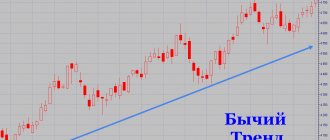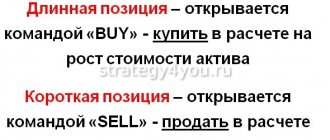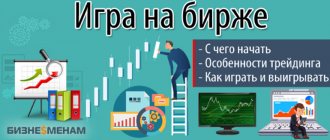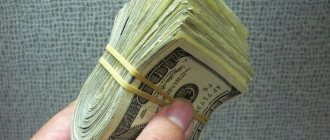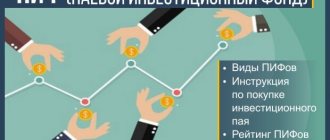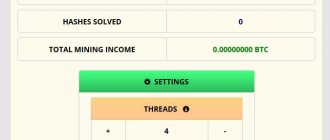Who are bulls and bears and why are they called that in financial markets? Initially, this was the name given to players who trade only on the stock exchange, then these concepts were transferred to other markets. Bears and bulls are the two most common types of traders, but in addition to them there is also a whole brood of different animals: sheep, hares, moose, lemmings, pigs and wolves. This is how various players are called in traders’ language (slang) for their trading style and behavior on the stock exchange.
What is the difference between “bulls” and “bears” on the stock exchange?
“Bulls” and “bears” are large groups of traders who are engaged in diametrically opposed activities.
Bulls make money by increasing the asset. Imagine that the dollar began to rise in price and in the near future this trend will most likely continue. The so-called “bull” purchases a batch of currency at price X, waits for the exchange rate to rise and sells dollars. The resulting difference is profit.
A “bear” sells dollars or any other asset at a low price, waits for quotes to decline and buys back the sold currency at an even lower cost. As a result, a difference in the form of profit also appears on the trader’s account.
How do bulls make money on the stock market?
There is such a thing on the stock exchange as an uptrend. At this time, the price of the asset shows a stable increase in value. The bull’s task is to have time to buy an asset that is starting to rise in price at the very beginning of the cycle and sell it at the best possible price. It is advisable to close the trade as close as possible to the trend reversal point - this will allow you to get the maximum profit.
It is believed that individual, large market players can artificially create excitement in order to provoke the start of an upward trend and make money from it. Although in most cases the chart moves for objective economic reasons, and market participants try to “catch” the trend.
How do bears make money on the stock market?
Bears enter the arena in times of financial turmoil, crisis or bad news. As soon as assets begin to lose value and go into a protracted downward trend, the “bears” begin to actively sell everything that they tried to hold on to until the right moment. After some time, if the forecast is confirmed, the assets will be repurchased at an even lower price.
The main task of the bears is to sell and re-purchase goods at the beginning and end of a downward trend. In this case, the margin will be the highest. The rapid decline in oil prices, as well as the financial turmoil of 2015-2016, are clearly characterized as a “bearish” period in the financial market.
Who is stronger
To answer the question of whether bulls or bears are stronger, let's look at the statistics in the materials of the consulting company in the field of global investments and business strategies Yardeni Research, Inc.
History shows that over the long term the bulls win. In terms of number, bullish periods are only 2 ahead of bearish ones, but significantly longer in duration. We observed the longest reigns of bulls from December 1987 to March 2000 - 4,494 days, from 2009 to 2022 - 3,999 days.
Experts distinguish between a correction and a bear market. In the first case, the reduction does not exceed 20%, and in the second case it is more than 20%.
From 2000 to 2009 there were 2 bear markets: the first was a decline of 49.1% for 929 days, the second was a decline of 56.8% for 517 days.
From 2009 to now, the only bear market in 2022 was in February and March, with the S&P 500 falling 33.9%.
The image below shows the bull market periods since 1928.
And bear market periods since 1928
Can a bull become a bear?
No one forbids moving from one status to another. There are traders who stick to one course all their lives. But lately there are fewer and fewer of them. Changing preferences depending on market conditions is much more profitable and therefore much more convenient.
Not everyone succeeds in concluding deals in close proximity to price lows and highs. Traders are adventurous by nature, so they tend to experiment and sometimes change their “game” strategy. Moreover, being in, say, “bear” status for a long period of time when the market is rapidly going up is simply pointless.
What does the phrase “the bullish trend is broken” mean?
Analysts say the upward trend breaks in two cases:
- The momentum did not update the previous high.
- The correction broke through the level of the previous low.
That is, like this:
Or like this:
What could this mean? In the classical sense, such a “break” means the end of a bullish trend. After the break, either a flat trend or a downward trend begins.
But in reality, the market can calmly continue to go up, that is, the trend will “recover” after a break. Here the trend survived three breaks, but still went up:
Bulls and bears: origin of terms
Several centuries ago, a famous British satirist named John Arbuthnot published a series of witty pamphlets with entertaining drawings. In 1712, stock traders first met a certain John Bull (from the word bull, i.e. “bull”). He, in addition to all the signs of a secular gentleman, had a real bull's head, on which was an elegant top hat. The second character, Bear, had a sharp tongue and annoyed his friend John with his jokes. The culmination of the communication between the two heroes was a real fight that took place on the stock exchange. Since then, the names “bulls” and “bears” have become firmly entrenched in the vocabulary of financial market regulars.
Other stock terms
“Hares” are traders with a high level of activity who try to make a profit on minor fluctuations in quotes. As a rule, transactions are closed within one session.
“Wolves” are traders with extensive experience. A losing trade is very rare for such market participants.
"Pigs" - hold an advantageous position until the last moment.
Sheep are overly cautious traders.
“Moose” (from the English word “loss” - “loss”) - representatives of this group regularly suffer losses.
“Lemmings” are market participants with minimal experience. They try to copy the behavior and transactions of more experienced colleagues.
Other market participants
The financial market involves not only professional traders, who from time to time wear the skin of a bear or the horns of a bull. Here you can meet beginners and experienced players, but with certain “tricks” that prevent them from moving up to the rank of main key figures. Since small players do not influence the state of the market, they are practically not mentioned anywhere.
Pig, rooster, hare, goat, dog, duck, cat
Hares
The distinctive features of the hare as an animal are lightness, agility and agility. They are applicable to traders in the market who are willing to work intensively to achieve their goal. Hares trade in the style of scalping and pipsing, in intraday mode. Their earnings are formed on minor exchange rate fluctuations, which they detect on lower time frames.
Traders execute many trades over a short period of time, which gives trading a high-risk, aggressive style. The hares have a small profit on one order, however, there can be many of them per day, which allows you to quickly disperse the deposit.
Successful trading is observed during the flat period, however, at the first signs of the emergence of a trend, players begin to feel uncertain about their decisions. A sharp change in the value of the acquired asset frightens them, as a result of which they begin to sell it, suffering losses.
Hares have every chance to become professional market players, subject to constant self-improvement and training.
Sheep
Many people associate sheep as animals in which fear predominates among all feelings. Among traders, this is the name given to cautious and attentive players who have a hard time parting with money and, if they decide to open a transaction, then after a thorough analysis of the market from different positions. As a result of the operation, they most often make a profit, although in some cases it is small.
Sheep spend most of their working time studying factors that could potentially influence the development of the market situation and making forecasts using various methods of analysis. Before making a decision, they cross-check all the data several times, taking into account different strategies.
Sheep often position themselves in the market as professional players, but if the situation begins to develop not according to plan, then such traders immediately lose confidence in themselves. Players cannot make prompt decisions in a rapidly developing market and often suffer failures due to the forced closure of orders by the broker. When stock exchange sheep suffer losses, experienced speculators say: “They shorn the sheep.”
Do you want to learn investing or improve your knowledge? Choose free and paid webinars from our partner - GlavInvest Academy.
Pigs
Pig traders are classified as professional players. They are fluent in all methods of analysis and can earn money, but their decisions are often rash. After a series of profitable trades, excitement takes over them, and the pigs can no longer stop. The thirst for quick profit becomes the reason for ignoring the regulations of one’s own trading strategy and violating the rules of money management, which leads to losses. Their sizes often exceed the amounts earned several times.
A neglectful attitude towards orders that limit losses leads to the fact that they hold on to the transaction even when it clearly becomes known that the forecast did not come true and one can expect a result from the operation that is radically opposite to what was expected.
Pigs are irresponsible. They usually invest a large amount of money in their deposit and work in impressive volumes. The main goal of pigs is to make a profit, but they are not interested in the size of the transaction, the quality and characteristics of the acquired asset. A frivolous approach to trading causes losses, but there are traders in this category who, based on the results of all transactions, come out with a profit.
Price formation and trade transactions
The formation of the price of an asset in financial markets depends primarily on the balance of supply and demand. For example, if the price of an asset increases, demand for it inevitably decreases. As a result, the number of sellers in the market increases and the number of buyers decreases. The opposite effect causes an increase in the volume of the asset on the market, after which the price returns to its original state.
The situation with the formation of the price per share is completely different. The determining factor here is the psychological attitude and expectations of experienced traders. The “real price” of certain securities often differs significantly from the market equivalent.
Advice from Sravni.ru:
Do you want to try your hand at trading? Carefully study the main strategies and choose yours.
Ostriches
An ostrich is an investor who does not react to critical situations or events that may affect investments. For example, if the Securities and Exchange Commission (SEC) starts investigating a company (an action that could harm the price of shares or tokens), the ostrich will simply ignore the news. The ostrich effect is one in which investors bury their heads in the sand, hoping for better days. Ostriches appear (or disappear) most often during bear markets, when people tend to experience the most financial stress.
